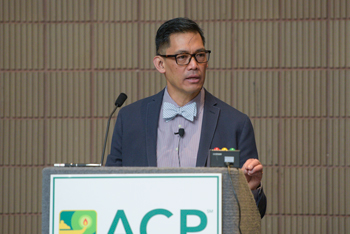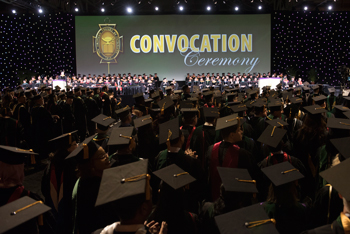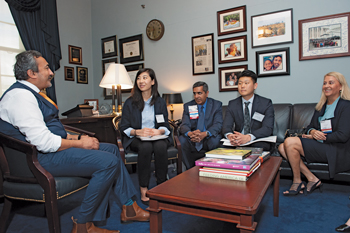New knowledge on human microbiome impacts practice
As researchers discover more and more associations between the human microbiome and various states of health and disease, physicians grow closer to the aim of precision health and providing customized care to patients.
You're not the only one enjoying your meals. The thousands of species of microbes inside of you get a taste as well, performing tasks like catabolism and bioconversion, explained Vincent B. Young, MD, PhD, during the first annual Dr. Ananda Prasad Lecture in Physiology at Internal Medicine Meeting 2018.
“The physiology of this community is very tied with our own physiology. … The number of genes inside these thousands of different types of microbes in you actually has a metabolic capacity that outstrips our own metabolic capacity by, depending on whose [estimates] you believe, at least an order of magnitude—maybe even two or three orders of magnitude,” he said.

The microbiome is defined as the community of microbes (e.g., bacteria, fungi, and viruses) and the given environment they inhabit, such as soil or the human body, said Dr. Young. The human microbiome is one of the most recent and highly publicized physiological discoveries to date, and thousands of papers in the scientific literature have begun to elucidate its role in health and disease, he noted.
“Clinicians should think about this, not necessarily how it affects your day-to-day practice now, but how it may affect it more in the future,” said Dr. Young, a professor in the departments of internal medicine/infectious diseases and microbiology and immunology at the University of Michigan Medical School in Ann Arbor.
Association vs. causation
Dr. Young explained up front that he doesn't have answers on how studying the microbiome will change the practice of medicine.
“Yet, I think there are lessons that we will learn with some more careful study along the lines of what Dr. Prasad did: going from basic science to translational science to clinical observation, completing that loop, this time with the idea of the microbiome.” (See sidebar for more about Dr. Prasad's work.)
There are caveats to microbiome research, however. Researchers can study microbiota of different individuals in great detail and find differences between them, “but just because we see those differences, we don't know what the causation is,” Dr. Young said.
As researchers discover more and more associations between the status of the microbiome and various states of health and disease, physicians grow closer to the aim of precision health and providing customized care to patients, he said.
“We are just beginning to move from these associations to causation,” Dr. Young said. “Once we understand some of this causation and understand the structure and function of the microbiome, perhaps we can move to the point where we can intentionally manipulate the microbiota to … prevent and treat diseases.”
In clinical practice
Despite the challenges of microbiome research, recent years have brought evidence in several fields such as infectious diseases, endocrinology, pharmacology, and oncology, Dr. Young noted.
Perhaps the most well-known impact of manipulating the human microbiome is in cases of recurrent Clostridium difficile, he said.
When Dr. Young asked the audience how many physicians have referred a patient with C. difficile to receive a fecal microbiota transplant (FMT), many hands went up in the air. “That's pretty significant. If I had asked this five years ago, I'd probably, first of all, get a lot of weird looks, and then probably only a few hands [would] go up,” he said.
A clear shift happened in 2013, when a randomized controlled trial of FMT, published in the New England Journal of Medicine, saw positive results and was stopped early, Dr. Young said. Overall, 15 of 16 patients (94%) who received FMT were cured, compared to four of 13 (31%) who received vancomycin alone.
“We've had a lot more studies now, and there was a recent meta-analysis that again backs this up. FMT has a much higher success rate for treating recurrent C. difficile infection as opposed to standard therapy, vancomycin,” he said.
How does this happen? “We assume we're restoring the microbiota,” Dr. Young said. Still, the specific mechanisms driving the success of FMT remain unknown. In a study published in 2014 by mBio, his group used molecular techniques to examine the microbiota of 14 patients treated with FMT for recurrent C. difficile infection, 12 of whom responded positively to treatment.
Prior to receiving the intervention, patients with recurrent C. difficile have a less diverse community of microbes than healthy donors, he said. Yet two patients in his study who responded to FMT still had low-diversity communities, Dr. Young noted.
“Even though they had low diversity, they had the right organisms, whatever it was,” he said. “Because remember, we're giving unfractionated feces. Do we know what's really important in there? We don't. But … we transplanted the ones that mattered.”
‘The promise is there’
Other clinical implications of the microbiome are more uncertain. For example, studies of the microbiome's role in obesity have been somewhat controversial “because this is a complex problem,” Dr. Young said, noting variabilities in diet and the location of microbes.
Although researchers cannot leap to causation, they are beginning to look at the potential mechanisms by which microbes can influence obesity, such as through bile acids, which can signal back to the liver and influence metabolism, he said. “Certain bile acids are known to be tumor promoters or, in some cases, perhaps tumor initiators. So just this metabolism of something [as] simple as bile by us and our microbes can truly impact our physiology and health.”
In the realm of pharmacology, Dr. Young offered the metabolism of digoxin as another example of the microbiome at work. “We all are taught in medical school, digoxin has a very narrow therapeutic index. Between giving enough to treat a patient's arrhythmia and poisoning them, there's not a whole lot.”
Research has pointed to microbiota as an explanation. In 1983, a report in Science explained that the gut bacterium Eggerthella lenta could metabolize digoxin in a test tube. More recently, a 2013 report in Science showed that different strains of E. lenta had varying abilities to metabolize the drug and that their ability to metabolize digoxin was influenced by other bacteria in the microbiome.
Therefore, a patient's predisposition to be a fast or slow metabolizer can be influenced by their gut microbes, Dr. Young said. “Does anyone think about that when they're prescribing medications? I certainly don't, and I don't know how to think about that yet,” he said.
In oncology, two basic science studies published in 2015 by Science found that gut microbes also influence cancer immunotherapy affecting the CTLA-4 and PD-L1 pathways, Dr. Young noted. In the first study, when researchers treated tumors in sterile mice, “There was no effect of the anti-CTLA-4 antibodies, and if they also gave antibiotics, they could blunt the effect of the anti-CTLA-4 antibodies,” he said.
In the second study, researchers bought mice with the same genetic background from two different vendors. “They saw that the anti-tumor response varied depending on where you bought your mice, even though they're genetically identical,” said Dr. Young, adding that cohousing the mice erased the differences in tumor growth.
Of course, mice are not people. However, three papers published in 2018 by Science showed that there are specific markers of the microbiota that can influence outcomes in human patients being treated with immunotherapy, he noted. Although medicine currently has no way to reproducibly manipulate microbiota to make nonresponders into responders, “The promise is there,” Dr. Young said.




